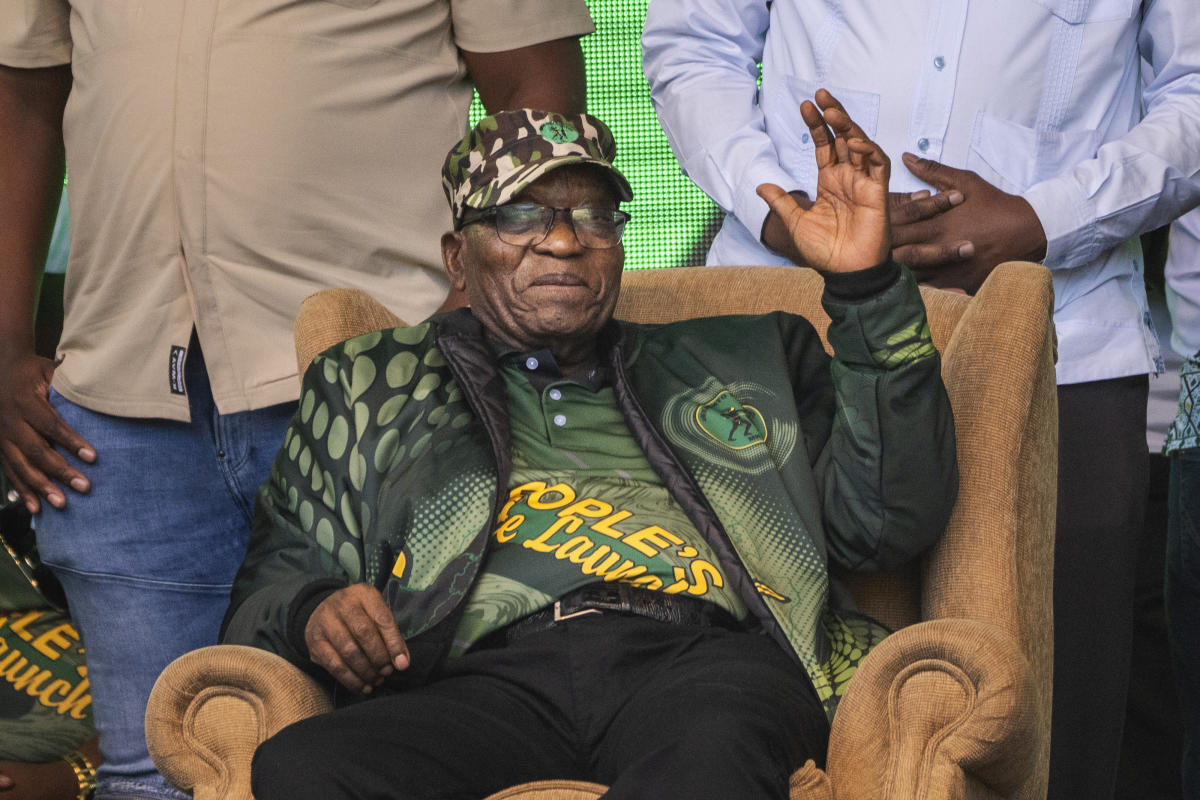Houston took a twin-track approach this offseason, trying to balance a championship window with maintaining future flexibility. After an unexpected playoff run, with the top two rookies in the league, oodles of cap space and no first-round pick, it would have been easy to toss money around like a nepo baby in Cabo.
But the Texans showed restraint. They didn’t splurge away their cap space by tying expensive veterans to long-term deals. Instead, they traded for wantaway stars, picked up a couple of ring-chasing veterans and took punts on fallen blue-chip prospects. They traded for Stefon Diggs to beef up their receiving corps, and made another deal for running back Joe Mixon. In free agency, they signed edge-rusher Danielle Hunter, defensive lineman Denico Autry, linebacker Azeez Al-Shaair and cornerback Jeff Okudah, a former first-round pick.
Houston recognize they’re in a win-now window. They have the most valuable asset in the league: a top-10 quarterback on a (cheap) rookie contract. But they are approaching that window with caution, protecting themselves should things sour: they reworked Diggs’s deal, turning it into a one-year trial; Hunter’s contract has a two-year opt-out if the injury bug bites again; Autry’s deal effectively functions as a one-year contract; Mixon and Al-Shaair were handed multi-year contracts that shrink each season.
Diggs is the headline grabber, but picking up Hunter, Autry and Al-Shaair may be what puts Houston over the top. No defense is as reliant on a true four-man rush as Houston’s. Adding Hunter and Autry alongside Will Anderson and Derek Barnett should spice up a group that finished third in pass-rush win rate last season.
Related: NFL draft 2024 winners and losers: Chicago shine as Denver disappoint
The addition of Al-Shaair could be most impactful move of all. DeMeco Ryans’s defense demands a linebacker who is comfortable in coverage. In an era when the lines are blurred on coverage assignments, Ryans runs a rigid system. There are clear delineations between the defensive line, linebackers and secondary. In his first year in Houston, Ryans did not have an every-down linebacker essential to the team’s defensive system. It led to a hockey-style rotation, with opposing offenses able to figure out what Houston were running based on the personnel on the field. Al-Shaair, who played for Ryans in San Francisco, should help fix the problem.
Houston are ahead of schedule. But they will enter 2024 with playmakers on offense, a talented o-line, a loaded secondary, a ferocious defensive front and one of the best young quarterbacks in the league. That’s as good a cocktail for a postseason run as any in the AFC.
Chicago Bears
How many cigars do you think Chicago GM Ryan Poles has worked through this offseason? What about glasses of champagne?
It hasn’t been a perfect offseason for the Bears, but it’s been as near as makes no difference. Drafting Caleb Williams No 1 overall was the jewel of the offseason, but the Bears have done plenty to help him out.
Entering the offseason, Chicago decided to stick with head coach Matt Eberflus (a defensive-minded coach) and spent the bulk of their resources addressing concerns on offense. When a team has a talented, young quarterback, there’s usually a race to surround them with talent. The Eagles traded for AJ Brown to help push Jalen Hurts to a new level. The Dolphins dealt for Tyreek Hill to figure out what they had in Tua Tagovailoa. The Bengals reunited Joe Burrow with Ja’Marr Chase through the draft.
In Chicago, the infrastructure is already in place. The offensive line is flush with young talent. They added Shane Waldron as offensive coordinator this offseason, one of the league’s underrated warlocks. In free agency, they signed running back D’Andre Swift and tight end Gerald Everett, two solid veterans. Crucially, they stole receiver Keenan Allen from the Chargers in exchange for a fourth-round pick.
Throwing cash and picks at veterans can be dicey. But the Bears have built their offense piece by piece. The receivers’ skill sets align: Allen is a savvy veteran who increases a quarterback’s margin for error; DJ Moore is the burner, a one-man offense who can create after the catch or separate from anyone, anywhere on the field; Rome Odunze is a 6ft 3in, 212lbs jar of polish. If you’re putting together a list of the most talented starting receiver trios, the Bears probably crack the top five.
On defense, they retained star cornerback Jaylon Johnson a couple of months after signing edge-rusher Montez Sweat to a long-term extension. The latter move is particularly important: after falling flat – again – early last season, Chicago’s defense caught fire after the team acquired Sweat at the trade deadline. Over the final nine weeks of the season, the Bears finished fourth in EPA/play, a measure of down-to-down effectiveness. The pieces are in place for the Bears to field a top-10 unit in 2024.
Williams is walking into a rare situation. He is a No 1 overall pick at quarterback stepping into a playoff-caliber roster which has postseason expectations rather than hopes. No pressure, rook.
New York Jets
If you can unplug yourself from the fact the Jets star quarterback appears to spend an inordinate amount of his time on the r/conspiracy page, the Jets have done good work this offseason.
(A side note: Aaron Rodgers’s predilection for browsing the internet does have a football angle. Rodgers and his buddy/Jets OC Nathaniel Hackett run one of the most sophisticated offenses in the NFL. It is unusually complex even by professional standards. It takes time, reps and intelligence to install. The Jets would be better off having Rodgers sit on Zoom calls with his teammates rather than chopping it up with podcasters.)
Addressing the offensive line was the most pressing concern for New York. The Jets conceded a pressure on 50% of their dropbacks last season and allowed 64 sacks, in part due to the ball not coming out quickly enough and partly due to the lack of talent along the offensive line. One of those sacks was enough to cost Rodgers his season.
General manager Joe Douglas wasted no expense hunting for upgrades on the line. The Jets signed the ageing (but excellent) left tackle Tyron Smith in free agency along with guard John Simpson, and they traded for right tackle Morgan Moses. In the draft, they ignored calls to pick another weapon for Rodgers and settled on tackle Olu Fashanu with the 11th overall pick.
There were savvy moves elsewhere. Receiver Mike Williams was picked up in the Chargers’ fire-sale, and edge-rusher Haason Reddick was added in a trade with the Eagles. They also signed interior lineman Javon Kinlaw, who will add some oomph to the team’s pass-rush. Notably, they added Tyrod Taylor as the backup quarterback, who should bring some maturity to the quarterback room and will be a viable replacement if Rodgers, who will turn 41 in December, misses any time. In the mid-rounds of the draft, they added some sizzle, drafting cornerback Qwan’tez Stiggers, running back Braelon Allen and receiver Malachi Corley, who went by the name ‘YAC King’ during an explosive college career.
On paper, the Jets have a deep and talented defense. And there’s the potential for fireworks on offense if the group can stay healthy. Hang the banner, Jets fans. It’s another offseason championship – their fans will hope that, for once, the team can maintain that success once the actual games start.
Green Bay Packers
The Packers did not take a big swing to add talent around Jordan Love, betting instead on the growth of their young players on offense. But they deserve credit for being aggressive in trying to upgrade their biggest need: safety.
Safeties are vital in the modern NFL, and last year Green Bay’s group at the position were a mess. They overhauled this offseason, doling out cash and spending draft picks on four new safeties. They signed Xavier McKinney in free agency, one of the most malleable safeties in the NFL. Spending $68m on a safety is out of character for the frugal Packers, but landing a top-tier player at the position was a necessity. What was in character for a team that loves developing young talent and stocking up on positions of need was picking up three additional safeties in the draft: Javon Bullard, Evan Williams and Kitan Oladapo.
Safeties boost what a defense can do. The NFL is past the point of having safeties with individual roles: a ball hawk who plays deep and a masher who plays closer to the line of scrimmage. In the past, teams have typically carried two of each. But as the game has evolved, having role-specific safeties means locking yourself into a structure that’s incompatible with the modern game. These days, every safety needs to be versatile. All four additions in Green Bay fit that bill. They can play deep in the defensive backfield, line up in the slot, blitz or stand up in the box.
Adding new defensive coordinator Jeff Hafley is a major plus, too. Green Bay finished 23rd in EPA/play last season. Over the second half of the season, that worsened to 26th. If the Packers can reach a league-average level, they will run the Lions close in the NFC North.

Daniel Miller is a sports fanatic who lives and breathes athletics. His coverage spans from major league championships to local sports events, delivering up-to-the-minute updates and in-depth analysis for sports enthusiasts.







